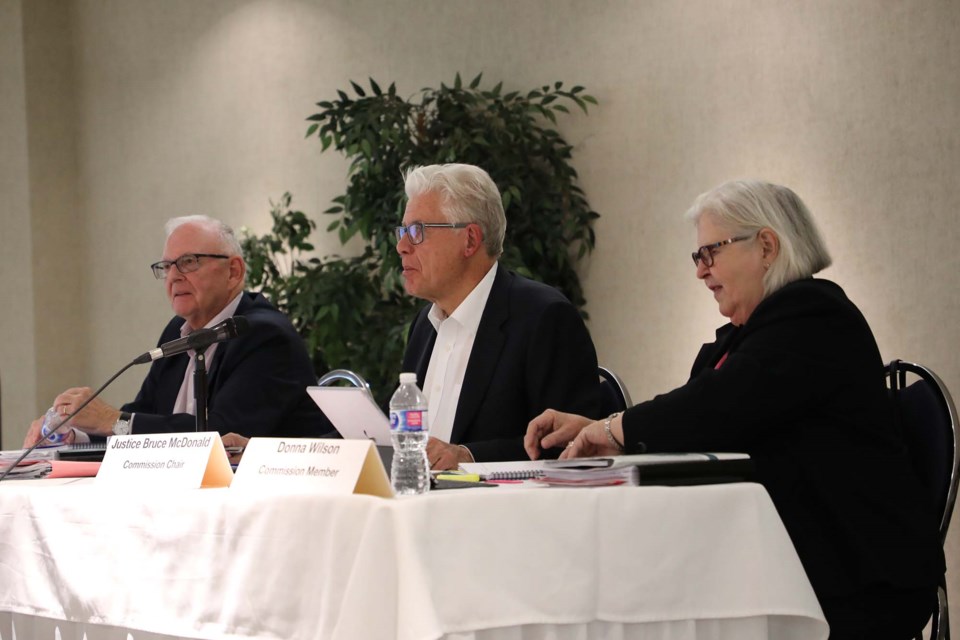Presenters praised the proposed boundary for the redistributed federal electoral district of Sturgeon River, but not its potential new name, at a public hearing in St. Albert Tuesday evening.
The Alberta Commission for the federal electoral district redistribution held a hearing at the St. Albert Inn and Suites on Sept. 13 for the public to give feedback on proposed changes the commission made to Alberta's federal electoral districts.
Around 15 people attended the hearing, eight of whom presented to the three-person commission, including St. Albert Mayor Cathy Heron. Two presenters were not present and had their letters read into the record.
At issue for many is the use of a proposed new name — Sturgeon River — for a riding with new boundaries that will include St. Albert and Morinville.
St. Albert Mayor Cathy Heron gave a presentation to the commission on behalf of city council stating that council believes the riding would be better served if St. Albert was included in the nomenclature.
Heron proposed the name St. Albert-Morinville. She also said the name St. Albert-Sturgeon River “would be fine.”
Commission chair Justice Bruce McDonald, along with members Donald Barry, a professor emeritus of political science at the University of Calgary; and Donna Wilson, a member of the 2012 Federal Electoral Boundaries Commission for Alberta, listened and asked questions of those who gave feedback — both positive and negative — about the proposed changes.
Presenters were allotted a 10-minute maximum of speaking time. Half of the presenters spoke on the proposed Sturgeon River district, while the other half spoke on issues concerning proposed Edmonton districts.
The proposed riding of Sturgeon River will stretch across into the territory which is now known as Sturgeon River-Parkland. It will include St. Albert, which had a population of 69,789 in 2021, according to the Alberta regional dashboard. The electoral district will contain a total of 114,803 people.
Under the Constitution of Canada, federal electoral districts are reviewed every 10 years after each decennial census.
McDonald said in a previous interview with The Gazette the population in Alberta increased by about 800,000 people since the last decennial census in 2011. According to data from Statistics Canada, the population of Alberta in 2021 was 4,262,635, up from a population of 3,645,257 in 2011.
“Under the formula that applies to Alberta and most other provinces, we were allocated three additional electoral districts, or ridings, to reflect that increase in population,” said McDonald.
McDonald said the commission was then tasked with building a proposal based on 37 electoral districts, an increase from 34.
Former St. Albert mayor Richard Plain spoke at Tuesday's hearing on behalf of the St. Albert-Edmonton Electoral District Association. Plain said the commission did a good job on the proposed boundary, however, the association would like to see St. Albert included in the proposed name.
Susan Evans, president of the Sturgeon River-Parkland Conservative Association, had asked prior the event to have her letter read into the record by McDonald.
“The proposed redistribution of the federal electoral district 2022, while not perfect, appears to be reasonable and therefore has the board's support,” McDonald read on behalf of the association, which suggested changing the name from Sturgeon River to St. Albert-Sturgeon River.
The association also suggested a name change for the proposed electoral district of Spruce Grove-Leduc to Parkland-Leduc which, read McDonald, would allow “for better identification and an overall community ownership.”
Garry Wetsch, chair for the St. Albert District Chamber of Commerce, also presented to the commission Tuesday evening.
Wetsch said the chamber supports the move of St. Albert into the Sturgeon River boundary, as the communities within share many of the political, cultural, social, and commercial interests.
“Our city is an integral part of the county,” said Wetsch, adding the proposed boundary is a step forward.
However, Wetsch said the chamber had a friendly recommendation: “We propose changing the proposed name of the electoral district from Sturgeon River to St. Albert-Sturgeon River.”
McDonald responded with a smile.
“I think you're going to be pleased with the new name that appears for this electoral district.”
The commission is welcoming public feedback on proposed boundary changes for federal electoral districts — including names — until Nov. 1 through emailed or written correspondence, or at one of several public hearings to be held across the province
The commission is set to file a report in Parliament based on feedback from the public on the proposed changes by Dec. 15.
According to the redistribution website, changes to the new federal electoral districts could be in effect for the general election held after April 1, 2024.
Information on how to reach the commission can be found at: https://redecoupage-redistribution-2022.ca/com/ab/phrg/index_e.aspx




